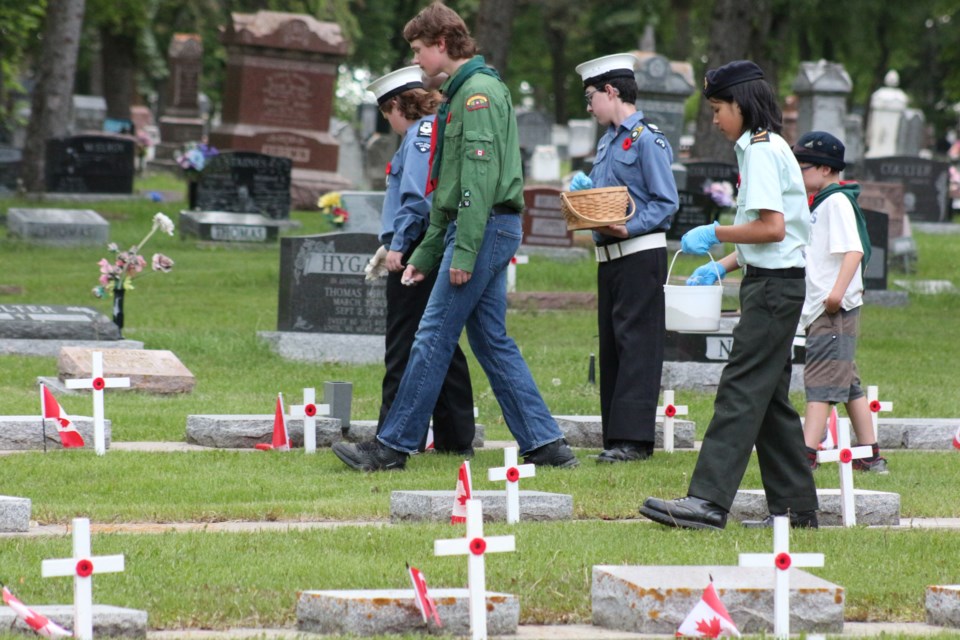REGINA — A non-profit organization, the Last Post Fund has provided financial benefits to nearly 150,000 service men and women. It is their mission to ensure that no veteran is denied a dignified funeral and burial. As well, as proper recognition of military gravestones, as some may have had insufficient funds at the time of death to do so.
Their website, , contains numerous details about their mission and their work.
“Without the gracious time and effort in the work of RM secretaries and town clerks and other keepers of records to help the LPF efforts, some of their research on who and where to help would not be possible,” says Greg Mulatz, member of the Saskatchewan chapter of LPF.
The Last Post Fund has two core programs. The first is the funeral and burial program which has been their primary mandate since 1909. It is funded and delivered on behalf of Veterans Affairs Canada (VAC).
The second program is the Unmarked Grave Program (UGP), created in 1996 with the objective of providing a permanent military marker for eligible veterans who lie in unmarked graves for at least five years. It is supported financially by VAC and private donations.
In March 2019, the UGP launched initiatives that included the Indigenous Veterans Initiative (IVI) with a particular focus on veterans from Indigenous communities and offers an additional inscription of the veteran’s traditional name to new and existing military markers.
The Lost Veterans Initiative (LVI) was launched in February of 2021 to stimulate and provide support to volunteer researchers who are seeking unmarked veterans’ graves. The website gives details on this program and initiative details.
Lost veterans refers to those veterans who lay in unmarked graves and it is estimated that there may be several thousand such graves across Canada. The efforts strive to provide a permanent military headstone to these veterans. Volunteers are welcome to contact their provincial branch for help in getting started with an information package.
“Since the initiative’s inception to date (three and a half years), Saskatchewan volunteer researchers, our ‘boots on the ground.’ found over 200 lost veterans in cemeteries across the province who can finally be commemorated with a military-style marker,” says the Saskatchewan Branch of LPF.
The LPF has a national office in Pointe-Claire, Que. staffed with 12 full-time employees, along with a national board and 10 provincial boards, with no physical offices.
Families of veterans can contact the LPF to apply for a headstone for a deceased family member under the program. When this is not the case, the program relies on volunteers to report unmarked graves.
The LVI has 10 provincial leads or co-ordinators, who are responsible for leading the search efforts of its volunteer researchers.
“In Saskatchewan we currently have 14 volunteer researchers, primarily concentrated and working from Regina and Saskatoon, with individual representation residing in Indian Head, Moose Jaw, Battlefords, and Prince Albert. Areas underrepresented include Meadow Lake, Melfort, Humboldt, Wynyard, Yorkton, Melville, Estevan, Maple Creek and Kindersley,” says Captain(retired) John Helms, CD, Last Post Fund, Saskatchewan Branch Unmarked Grave Program co-ordinator.
“Our definition of a veteran goes beyond those who served in a war.” says Helms.
“LPF defines it as ‘Any former member of the Canadian Armed Forces (regular or reserve) or any predecessor naval, army or air forces of Canada or Newfoundland since Confederation (01 July 1867); or Canadian Merchant Mariner of WW1, WW2 or the Korean War; or Allied Veteran who is buried within Canada.’”
“Preparation is the key to a successful cemetery search for Lost Veterans,” the organization says.
“First, plan your cemetery search in terms of who administers the cemetery and find out if there is (a) a Field of Honour (FOH) or Military Section and (b) a cemetery map and/or grave register. Second, visit the cemetery’s FOH and take note of any temporary markers and gaps between existing markers. Third, note the location /direction of the rows and neighbouring marked graves (take pictures).
“In the search for unmarked grave(s), contact the cemetery administration to confirm there is someone buried there and get the particulars of the person buried. Check for their military service by consulting obituaries, and the various databases made available to volunteer researchers. If or when a lost veteran is found it is asked that you complete and submit the Preliminary Information Sheet, found as a link on the LPF UGP website, along with your supporting documentation to [email protected].”
Helms reports that since the LPF inception, 9,400 unmarked veterans’ graves in Canada have been identified and marked.
Helms said he served for 39 years in the Canadian Army (Reserve) and after retirement he joined the LPF, Saskatchewan Branch, to ensure veterans and their families are made aware, and have access to its programs and initiatives.
Helms is the former branch president.
“To quote our founder, Arthur Hair, ‘The Last Post Fund is not a charity, it is a duty,’” Helms says.




